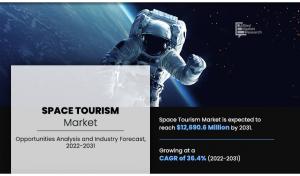Space Tourism Market Expected to Accumulate a Revenue of $12,690.6 Million by 2031, Growing at a Healthy CAGR of 36.4%
Space tourism is human space travel for recreational purposes. There are several different types of space tourism, including orbital and suborbital
PORTLAND, 5933 NE WIN SIVERS DRIVE, #205, UNITED STATE, March 14, 2023 /EINPresswire.com/ -- According to a new report published by Allied Market Research, titled, “Space Tourism Market by Type and End Use: Global Opportunity Analysis and Industry Forecast, 2022–2031,” the space tourism market size was $598.4 million in 2021 and is expected to reach $12,690.6 million by 2031, registering a CAGR of 36.4% from 2022 to 2031.
The market for space tourism is mostly driven by the rising trend of space tourism across the globe. The market for space tourism is expected to grow faster than expected throughout the projected period as the practice becomes more widely accepted in international markets. In addition, it is anticipated that increasing competition in the space tourism sector will drive down prices. Furthermore, as the orbit is reached by the next-generation space planes, the cost of entering space is anticipated to fall sharply. As a result, the price of launching satellites is probably going to drop significantly, which would lower the overall cost of space exploration operations. As a result, space flight will eventually become a viable economic option.
Request For Sample :- https://www.alliedmarketresearch.com/request-sample/11039
The space tourism market shows high growth potential in Asia-Pacific and LAMEA. Significant contributors to the growth of the Asia-Pacific market include the China National Space Administration (CNSA), the Indian Space Research Organization (ISRO), and Japan Aerospace Exploration Agency (JAXA). CAS Space, a Chinese Academy of Sciences (CAS) spinoff, has been developing rockets for commercial satellite launches.
On the other side, the environment is harmed by space travel. Launches of rockets harm the environment in general. Ozone depletion is caused by the discharge of hazardous gases and black carbon (soot particles) into the upper atmosphere by rocket engines using rocket fuels. Some space firms, though, don't use black carbon as fuel. Rockets powered by liquid hydrogen-hydrogen fuel are used by businesses like Blue Origin's New Shepard. Burning hydrogen produces water vapor instead of carbon dioxide. Such factors are restraining the space tourism market growth.
The space tourism market forecast is segmented on the basis of type, end use, and region. On the basis of type, the market is divided into orbital and sub orbital. The sub orbital segment accounted for a major space tourism market share in 2021, and is expected to grow at a significant CAGR during the forecast period. Suborbital tourism is on the rise as it allows individuals to experience weightlessness and observe space without actually exiting the Earth's orbit. As a result, human spaceflight can reach the edge of the universe without entering orbit.
Request For Customization :- https://www.alliedmarketresearch.com/request-for-customization/11039
As per end use, the space tourism market analysis is segmented into Government and commercial. The commercial segment accounted for a major share of the market in 2021, and is expected to grow at a significant CAGR during the forecast period. The commercial space tourism market is rising and expected to dominate the market. There were thirteen commercial spaceflight missions undertaken by several private and government organizations, of which seven missions were executed successfully. Billionaires have invested considerable sums in traveling to space and witnessing the Earth from above.
In 2021, North America accounted for 43.7% share in the global space tourism market and is expected to maintain its dominance during the forecast period. However, LAMEA and Asia-Pacific are expected to possess the highest CAGRs, owing to the rising space tourism market trends and Focus on Research and Development (R&D) initiatives by market players.
The COVID-19 epidemic has had a significant impact on the commercial aviation sector and has prevented many people from travelling for both leisure and business. The growth of the space tourism market has been hampered by the setback in the travel and tourism sector. It is believed that this effect may lengthen space missions and momentarily halt long-haul missions. There are now more options for supersonic and hypersonic flights because to the expansion of corporate jet travel and in-flight connectivity. When compared to other mediums, it has enabled the companies to realize the potential for time savings on long-haul flights.
The major players analyzed for the global space tourism industry is Blue Origin, Virgin Galactic, SpaceX, Airbus Group SE, Boeing, ZERO-G, Axiom Space, Bigelow Aerospace, Orion Span, Space Adventures, Space Perspective, World View Enterprises, Zero2Infinity.
Procure Complete Report (334 Pages PDF with Insights, Charts, Tables, and Figures) @checkout link :- https://www.alliedmarketresearch.com/checkout-final/e808632e3ca41277bb3e026376e73795
KEY FINDINGS OF THE STUDY
By type, the sub-orbital segment was the highest revenue contributor to the market with $355.3 million in 2021 and is estimated to reach $7,227.7 million by 2031, with a CAGR of 35.8%.
Depending on end-use, the commercial segment was the highest revenue contributor to the market, with $348.2 million in 2021, and is estimated to reach $7,046.4 million by 2031, with a CAGR of 37.7%.
Region-wise, North America was the highest revenue contributor, accounting for $267.2 million in 2021, and is estimated to reach $4,936.7 million by 2031, with a CAGR of 34.6%.
Similar Reports :-
Camping Equipment Market
Australia Adventure Tourism Market
David Correa
Allied Analytics LLP
+1-800-792-5285
email us here
Legal Disclaimer:
EIN Presswire provides this news content "as is" without warranty of any kind. We do not accept any responsibility or liability for the accuracy, content, images, videos, licenses, completeness, legality, or reliability of the information contained in this article. If you have any complaints or copyright issues related to this article, kindly contact the author above.

